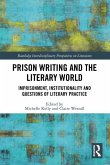This book focuses on the numerous examples of creativity produced by POWs and civilian internees during their captivity, including: paintings, cartoons, craftwork, needlework, acting, musical compositions, magazine and newspaper articles, wood carving, and recycled Red Cross tins turned into plates, mugs and makeshift stoves, all which have previously received little attention. The authors of this volume show the wide potential of such items to inform us about the daily life and struggle for survival behind barbed wire. Previously dismissed as items which could only serve to illustrate POW memoirs and diaries, this book argues for a central role of all items of creativity in helping us to understand the true experience of life in captivity. The international authors draw upon a rich seam of material from their own case studies of POW and civilian internment camps across the world, to offer a range of interpretations of this diverse and extraordinary material.
'This book addresses an important body of material culture - formerly regarded, at best, as ephemeral souvenirs; at worst, as mere kitsch - and rescues it as a source for comprehending the experience of those made captive in wartime.' - Paul Cornish, Imperial War Museum, UK
'Ingenuity, fortitude and resourcefulness emerge as the hallmarks of 'creativity behind barbed wire...it remains a fascinating and analytically skillful volume and represents a significant contribution to prisoner-of-war studies.' - Grace Huxford, Journal of Contemporary History, 48(3)
'Ingenuity, fortitude and resourcefulness emerge as the hallmarks of 'creativity behind barbed wire...it remains a fascinating and analytically skillful volume and represents a significant contribution to prisoner-of-war studies.' - Grace Huxford, Journal of Contemporary History, 48(3)








